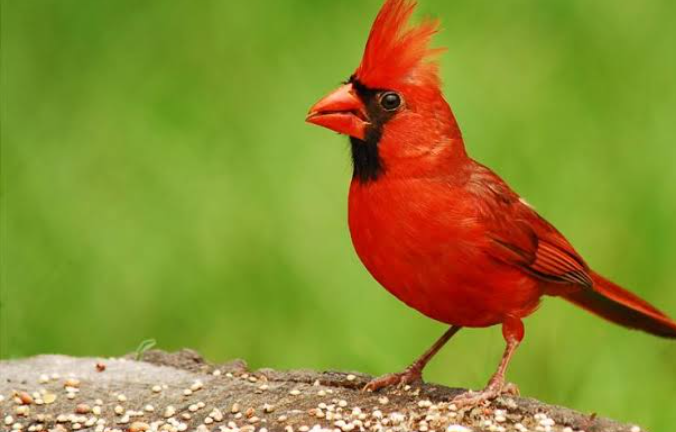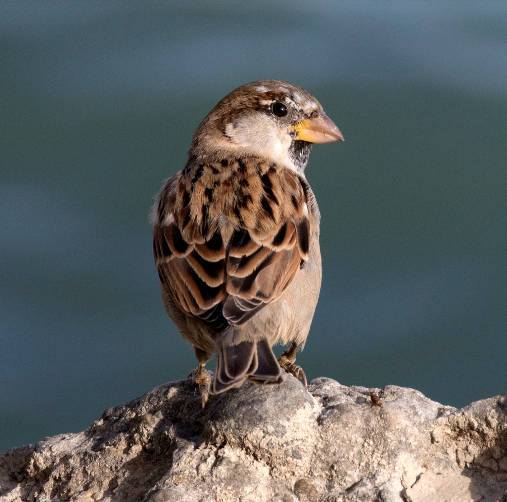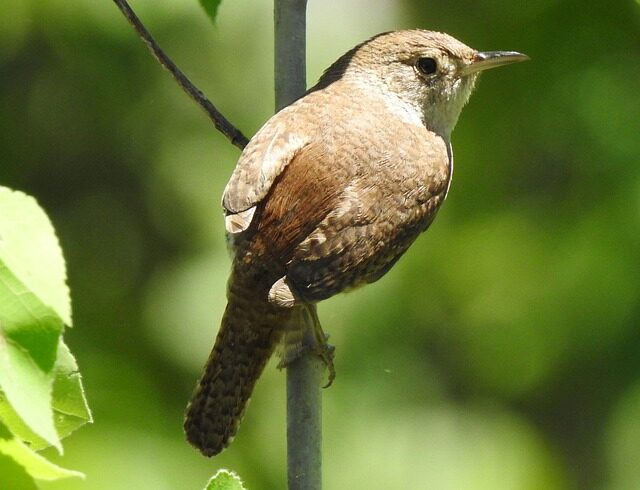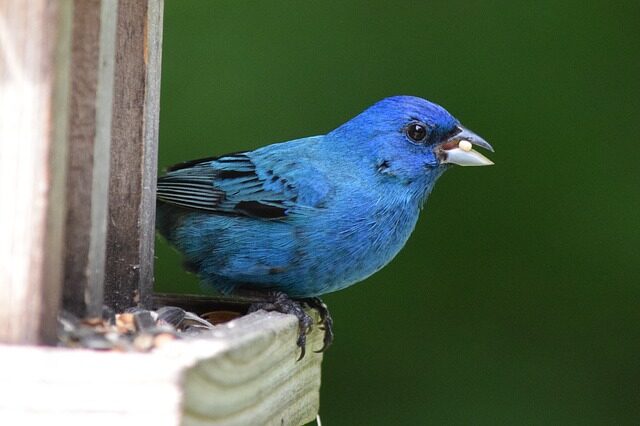Have you wondered what those birds are that are visiting your backyard in Illinois? Do you need help identifying common backyard birds in Illinois?
There is a great joy in putting up bird feeders and watching what comes to visit, but it gets better if you know who they are. Well, now you can find out the most common birds in Illinois that visit feeders or hop across your lawn.
So if you’re ready to do some backyard birding in Illinois, then read on to find out how to identify birds and attract more birds to your yard.
20 Most Common Backyard Birds in Illinois:
- Northern Cardinal
- American Robin
- Dark-eyed Junco
- Mourning Dove
- Song Sparrow
- American Goldfinch
- Red-winged Blackbird
- House Wren
- Common Yellowthroat
- European Starling
- American Crow
- Common Grackle
- Indigo Bunting
- House Sparrow
- Downy Woodpecker
- Black-capped Chickadee
- American Tree Sparrow
- Blue Jay
- Gray Catbird
- House Finch
The 20 most common birds in Illinois
1. Northern Cardinal
 northern cardinal
northern cardinal
| Kingdom: | Animalia |
|---|---|
| Phylum | Chordata |
| Class | Aves |
| Order | Passeriformes |
| Family | Cardinalidae |
| Genus | Cardinalis |
| Species | C. cardinalis |
| Length | 21 – 24 cm |
| Weight | 43 g |
The brilliant red male Northern Cardinal with black around his face stands against the white winter background. With their brown coloring, pointed brown crest, red accents, and red beaks, the females are likewise a little spectacular.
The male is a bright red, while the female is a reddish olive. The northern cardinal is mostly a granivore, but it also eats insects and fruit. The male acts territorially, singing to identify his area. The male feeds seed to the female beak-to-beak during courtship. Each year, a clutch of three to four eggs is deposited, with two to four grips produced. Initially, it was cherished as a pet, but the Migratory Bird Treaty Act of 1918 prohibited its sale as a caged bird in the United States.
During the breeding season, Northern Cardinals will occasionally attack their reflections to protect their territories fiercely. Sunflower seeds, peanut hearts, millet, and milo attract more Northern Cardinals to backyard feeders. Large tube feeders, hoppers, platform feeders, and food was thrown on the ground will all be used to feed them.
There are a surprising number of red birds to be found in Illinois.
2. American Robin
 American Robin
American Robin
| Kingdom | Animalia |
|---|---|
| Phylum | Chordata |
| Class | Aves |
| Order | Passeriformes |
| Family | Turdidae |
| Genus | Turdus |
| Species | T. migratorius |
American Robins are a common sight on lawns eating earthworms. They have blackheads and back with red or orange breasts. They tend to roost in trees in winter, so you are more likely to see them in your backyard from spring.
American Robins, the quintessential early bird, are familiar sights on lawns across North America, where they can often be seen yanking earthworms from the ground. Robins are well-known for their bright orange breasts, cheerful song, and early arrival towards the conclusion of the winter season.
Though they’re common in cities, American Robins can also be found in remote regions, such as mountain forests and the Alaskan wilderness.
They eat sunflower seeds, suet and peanut hearts, fruit, and mealworms. They may even eat mealworms out of your hand. Platform feeders are best or food scattered on the ground.
3. Dark-eyed Junco
 Dark-Eyed Junco
Dark-Eyed Junco
| Kingdom | Animalia |
|---|---|
| Phylum | Chordata |
| Class | Aves |
| Order | Passeriformes |
| Family | Passerellidae |
| Genius | Junco |
| Species | J. hyemalis |
Dark-eyed Juncos are sparrows that come in various hues depending on where they are found. In the east, they are slate-colored, whereas, in the west, they are black, white, and brown.
Carl Linnaeus, a Swedish naturalist, named the dark-eyed junco Fringilla hyemalis in his historic 1758 10th edition of Systema Naturae. The only information provided was the laconic remark “F[ringilla] nigra, ventral albo.” (“A black ‘finch’ with a white belly”) and the fact that it originated in America.
They are abundant over the continent and can be found in open and slightly wooded areas, generally on the ground. Black oil sunflower seeds, nyjer, cracked corn, millet, and peanuts can all be used to attract additional Dark-eyed Juncos to backyard feeders. The ideal feeders are platform feeders or those dispersed on the ground.
4. Mourning Dove
 Morning Dove
Morning Dove
| Kingdom: | Animalia |
|---|---|
| Phylum | Chordata |
| Class | Aves |
| Order | Columbidae |
| Class | Columbiformes |
| Genus | Zenaida |
| Species | Z. macroura |
Mourning Doves are small, graceful birds with plump bodies and long tails. The wings have light brown color with black markings.
It is one of the most numerous and widely distributed North American birds and a famous game bird, with over 20 million birds (up to 70 million in some years) shot for sport and meat in the United States each year. Its ability to maintain a population under such stress is due to its prolific breeding; in warm climates, one pair can raise to six broods of two young each year.
Perching on telephone wires and foraging for seeds on the ground can be observed. By sprinkling millet on the floor or platform feeders, you can attract more Mourning Doves to your yard. They’ll consume black sunflower seeds, nyjer, cracked corn, and peanut hearts, among other things.
5. Song Sparrow

| Kingdom | Animalia |
|---|---|
| Phylum | Chordata |
| Class | Aves |
| Order | Passeriformes |
| Family | Passerellidae |
| Genius | Melospiza |
| Species | M. melodia |
Song sparrows aren’t as noticeable as other backyard birds, but these primarily brown-streaked birds use their almost continual song to attract mates in the spring and summer.
Song Sparrows fly among low plants or low branches in search of food, occasionally landing on open ground. Flights are brief and fluttery, with a distinctive downward tail pumping. Male Song Sparrows sing from tiny trees exposed to the elements from perches.
They are commonly perched on a low shrub singing in open, shrubby, and damp settings. They’re frequently seen at backyard feeders. Put black oil sunflower seeds, cracked corn, and nyjer on platform feeders to attract more song sparrows to your backyard feeders.
6. American Goldfinch
 American Goldfinch
American Goldfinch
| Kingdom: | Animalia |
|---|---|
| Phylum | Chordata |
| Class | Aves |
| Order | Fringillidae |
| Family | Carduelinae |
| Genus | Spinus |
| Species | S. tristis |
The males of American Goldfinches have a bright yellow and black coloring in the spring. In the winter, females and males are both a dull brown color.
The American goldfinch is the only finch in its subfamily to go through a complete molt. The male is a vivid yellow in the summer and an olive color in the winter, while the female is a dull yellow-brown shade that brightens just slightly throughout the summer. The male wears brightly colored plumage during the breeding season to attract a mate.
Plant thistles and milkweed in your yard to attract more American Goldfinches. Most bird feeders will attract them, and they like sunflower and nyjer seed.
7. Red-winged Blackbird
 Red-winged Blackbirds
Red-winged Blackbirds
| Kingdom: | Animalia |
|---|---|
| Phylum | Chordata |
| Class | Aves |
| Order | Passeriformes |
| Family | Icteridae |
| Genus | Agelaius |
| Species | A. phoeniceus |
The all-black plumage of red-winged blackbirds, save for the vivid red and yellow shoulder patches, makes them simple to distinguish. In comparison to the streaky brown coloring of the males, the females are pretty drab.
A stocky, broad-shouldered blackbird with a medium-length tail and a narrow, conical bill. When perched, Red-winged Blackbirds have a hump-backed profile, and males often sit with their seats slightly flared.
They are frequently seen sitting on telephone wires, and during the breeding season, the males will fiercely protect their territory, even attacking individuals who come too close to nests. They roost in enormous flocks during the winter, numbering in the millions.
Spread mixed grain and seeds on the ground to attract more Red-winged blackbirds to your yard. They’ll eat enormous tube feeders or platform feeders as well.
8. House Wren
 House Wren
House Wren
| Kingdom | Animalia |
|---|---|
| Phylum | Chordata |
| Class | Aves |
| Order | Passeriformes |
| Family | Troglodytidae |
| Genus | Troglodytes |
| Species | T. aedon |
| Length | 11 to 13 cm |
| Weight | 10 to 12 g |
House Wrens are little brown birds with a lighter throat and darker barred wings and tails. They breed in most states before moving to the extreme south and Mexico for the winter.
Foraging insects and spiders such as beetles, caterpillars, and earwigs in brush heaps, House Wrens can be found in backyards, parks, and open woodlands. They’re frequently seen hopping through tangles and low branches with their tails raised, pausing to sing their happy song.
When it comes to getting the best nest holes, House Wrens are aggressive for their size, and they will often disturb larger birds, yanking eggs, or nestlings out of a nest site they prefer.
By leaving brush piles or erecting a nest box in your backyard, you might attract more House Wrens.
9. Common Yellowthroat
 Common Yellowthroat
Common Yellowthroat
| Kingdom | Animalia |
|---|---|
| Phylum | Chordata |
| Class | Aves |
| Order | Passeriformes |
| Family | Parulidae |
| Genus | Geothlypis |
| Species | G. trichas |
| Length | 4.3–5.1 in |
| Weight | 0.3–0.3 oz |
Yellowthroats are little songbirds with long tails that are brownish on the back and bright yellow beneath. The males wear a black mask that covers their entire faces. The intensity of the yellow varies by location, and some areas beneath the surface may appear more olive.
They breed across much of North America and can be found in marshy or wetland environments, brushy fields, and thick, tangled vegetation in the spring and summer. They eat giant insects and can be found in vast, densely vegetated backyards.
10. European Starling
 European Starling
European Starling
| Kingdom: | Animalia |
|---|---|
| Phylum | Chordata |
| Class | Aves |
| Order | Sturnidae |
| Family | Passeriformes |
| Genus | Sturnus |
| Species | S. vulgaris |
European starlings are not native to the United States, yet they have become common songbirds. They’re stocky black birds with purple, green, and blue iridescent tones.
European Starlings were first introduced to North America by Shakespeare fans in the nineteenth century, and they are currently among the continent’s most numerous songbirds. These stocky black birds characterize short tails, trapezoidal wings, and long, pointed beaks.
They’re dazzling birds when you get a good look at them, even if they’re frequently hated for their quantity and ferocity. They are covered with white dots during the winter, but they become dark and shiny in the summer. They circle through the sky and crowd lawns in large, raucous flocks for much of the year.
Some consider these birds to be pests because of their aggressive demeanor. They can be found perched in groups on the tops of trees or flying over fields in flocks. Black oil sunflower seeds, suet, cracked corn, and peanuts can all be used to attract more European Starlings to your backyard feeders.
11. American Crow
 American Crow
American Crow
| Kingdom: | Animalia |
|---|---|
| Phylum | Chordata |
| Class | Aves |
| Order | Passeriformes |
| Family | Corvidae |
| Genus | Corvus |
| Species | C. brachyrhynchos |
Crows in the United States are substantial blackbirds that produce a harsh cawing sound. They are common birds found in various environments such as trees, woods, fields, beaches, and cities.
They can be recognized from the common raven (C. Corax) by their size; from the fish crow (C. ossifragus) by the fact that American crows do not hunch and fluff their throat feathers when calling; and from the carrion crow (C. corone) by size, as the carrion crow is more prominent and stockier. They have a high level of intelligence and can adapt to human situations.
They eat a wide variety of foods and like to graze on the ground, where they eat earthworms, insects, seeds, and fruit. By throwing peanuts in your yard, you can attract additional American Crows.
12. Common Grackle
 Common Grackle
Common Grackle
| Kingdom | Animalia |
|---|---|
| Phylum | Chordata |
| Class | Aves |
| Order | Passeriformes |
| Family | Icteridae |
| Genus | Quiscalus |
| Species | Q. quiscula |
| Length | 28 – 34 cm |
| Weight | 110 g |
The Common Grackle is a blackbird with glossy iridescent bodies taller and longer-tailed than other blackbirds. They eat a variety of crops, but primarily corn, and congregate in noisy groups high in the trees.
The common grackle (Quiscalus quiscula) is a big icterid found across North America in enormous numbers. According to Carl Linnaeus, the common grackle has three subspecies, who first described it in 1758. The bill of an adult common grackle is long and dark, with pale yellow eyes and a long tail. Males, in particular, have an iridescent appearance on their heads. East of the Rocky Mountains, common grackles can be found across much of North America.
Most mixed grain and seed strewn on the ground or platform feeders can attract more Common Grackles to your garden.
13. Indigo Bunting
 Indigo Bunting
Indigo Bunting
| Kingdom | Animalia |
|---|---|
| Phylum | Chordata |
| Class | Aves |
| Order | Passeriformes |
| Family | Cardinalidae |
| Genus | Passerina |
| Species | P. cyanea |
| Length | 11.5–13 cm |
| Weight | 14.5g |
Indigo Buntings are tiny birds with vivid blue males and brown females with black streaks on their wings and tails. They migrate from their nesting areas in the eastern United States to Florida, Central and South America, and the Caribbean for the winter.
The indigo bunting (Passerina cyanea) is a seed-eating bird belonging to the Cardinalidae family. During the breeding season, it migrates from southern Canada to northern Florida, and during the winter, it migrates from south Florida to the north of South America.
It frequently migrates at night, navigating by the stars. Farmland, brushy regions, and open forests are its natural habitats. The indigo bunting is closely related to the lazuli bunting, and their ranges overlap; thus, they interbreed.
Indigo Buntings can feed on seeds and insects in weedy fields and shrubby places. Tiny seeds like nyjer and thistle can help you attract more to your yard.
14. House Sparrow
 House Sparrow
House Sparrow
| Kingdom | Animalia |
|---|---|
| Phylum | Chordata |
| Class | Aves |
| Order | Passeriformes |
| Family | Passeridae |
| Genus | Passer |
| Species | P. domesticus |
| Length | 14 – 18 cm |
| Weight | 24 – 40 g |
Another introduced species that has thrived and is now one of the most frequent birds is the House Sparrow. They’re ordinary near homes and buildings, and they’re incredibly tame, so they’ll eat right out of your hand.
They are pests since they are non-native, yet they will still be found in backyards if you do not feed them. Most types of birdseed, such as millet, corn, and sunflower seeds, will attract more House Sparrows to your backyard feeders.
15. Downy Woodpecker
 Downy Woodpecker
Downy Woodpecker
| Kingdom | Animalia |
|---|---|
| Phylum | Chordata |
| Class | Aves |
| Order | Piciformes |
| Family | Picidae |
| Genus | Dryobates |
| Species | D. pubescens |
| Length | 14 –17 cm |
| Weight | 21 – 28 g |
Downy Woodpeckers are tiny birds that use feeders in backyards. They’re frequently mistaken for other birds like chickadees and nuthatches. They have a red patch on the back of their heads and are black and white in appearance. They have a similar appearance to the Hairy Woodpecker.
Suet feeders are an excellent way to attract more Downy Woodpeckers to your yard, but they will also eat black oil sunflower seeds, millet, and peanuts from platform feeders.
In Illinois, you can see a variety of woodpecker species.
16. Black-capped Chickadee
 Black-capped_chickadee
Black-capped_chickadee
| Kingdom: | Animalia |
|---|---|
| Phylum | Chordata |
| Class | Aves |
| Order | Passeriformes |
| Family | Paridae |
| Genus | Poecile |
| Species | P. atricapillus |
| Length | four to six inches |
| Weight | 11 g |
The Black-capped Chickadee has a petite body and a large round head. These birds will happily eat from backyard feeders and will inspect everything, including you!
In the United States, it is the state bird of Massachusetts and Maine, while in Canada, it is the province bird of New Brunswick.
It is well-known for its ability to regulate its body temperature during cold winter nights, as well as its good spatial memory for relocating food caches and its bravery around humans (sometimes feeding on the hand).
They have black beaks and capes, white cheeks, gray backs, wings, and tails. Suet, sunflower seeds, and peanuts or peanut butter are all ways to attract additional Black-capped Chickadees. They’ll even eat out of your hand.
17. American Tree Sparrow
 American Tree Sparrow
American Tree Sparrow
| Kingdom | Animalia |
|---|---|
| Phylum | Chordata |
| Class | Aves |
| Order | Passeriformes |
| Family | Passerellidae |
| Genus | Spizelloides Slager & Klicka, 2014 |
| Species | S. arborea |
| Length | 5.5 in |
| Weight | 0.5 – 1.0 g |
After nesting in Canada, American Tree sparrows might be found in the winter. They’re plump brown-streaked long-tailed birds with rusty caps, gray cheeks, and rusty eyeliners. In weedy fields and under bird feeders, they graze in tiny swarms.
The winter sparrow, sometimes known as the American tree sparrow (Spizelloides arborea), is a medium-sized New World sparrow. It was previously classified as part of the Spizella genus; however, multilocus molecular evidence revealed that it should be placed in its genus.
Black oil sunflower seeds, nyjer, cracked corn, and millet can all be used to attract more American Tree Sparrows to your backyard platform feeders. They also forage for seeds fallen or discarded from above on the ground under tube feeders.
18. Blue Jay
 Blue Jay
Blue Jay
| Kingdom: | Animalia |
|---|---|
| Phylum | Chordata |
| Class | Aves |
| Order | Passeriformes |
| Family | Corvidae |
| Genus | Cyanocitta |
| Species | C. cristata |
| Length | 22 – 30 cm |
| Weight | 65 – 110 g |
Blue Jays have a blue erect crest, blue and black backs, white undersides, and common songbirds. They are loud birds that fly in family groups in search of acorns.
Seeds and nuts, such as acorns, which it may bury to eat later; soft fruits; arthropods; and, on rare occasions, tiny vertebrates, are the principal foods of the blue jay.
It feeds on trees, shrubs, and the ground and occasionally hawks insects from the air. Blue jays are hostile towards other birds, raiding nests and decapitating other birds.
Peanuts, sunflower seeds, and suet are favorites, but they prefer to eat them from tray feeders or hopper feeders mounted on a post. They’ll also appreciate a birdbath.
19. Gray Catbird
 Gray Catbird
Gray Catbird
| Kingdom | Animalia |
|---|---|
| Phylum | Chordata |
| Class | Aves |
| Order | Passeriformes |
| Family | Mimidae |
| Genus | Dumetella C.T. Wood, 1837 |
| Species | D. carolinensis |
| Length | 21 – 24 cm |
| Weight | 35 g |
Gray Catbirds get their name from their characteristic catty mew sound, lasting up to ten minutes. They’re medium-sized songbirds with slate-gray plumage, a black crown and tail, and a scarlet spot underneath their seats. Gray Catbirds can be found in dense shrubs, tiny trees, forest borders, and hedgerows.
Fruit and fruit trees or shrubs like dogwood, winterberry, and serviceberry will attract more Gray Catbirds to your backyard feeders.
20. House Finch
 House Finch
House Finch
| Kingdom: | Animalia |
|---|---|
| Phylum | Chordata |
| Class | Aves |
| Order | Passeriformes |
| Family | Fringillidae |
| Genus | Haemorhous |
| Species | H. mexicanus |
Male House Finches have a redhead and breast, while females have brown-streaked coloring. It was initially exclusively found in western states, but it was introduced to eastern states and has thrived, even displacing the Purple Finch.
Parks, farms, woodland margins, and backyard feeders are excellent places to look for them. They congregate in large, boisterous groups that are difficult to miss. Black oil sunflower seeds or nyjer seeds in tube feeders or platform feeders will attract more House Finches to backyard feeders.
